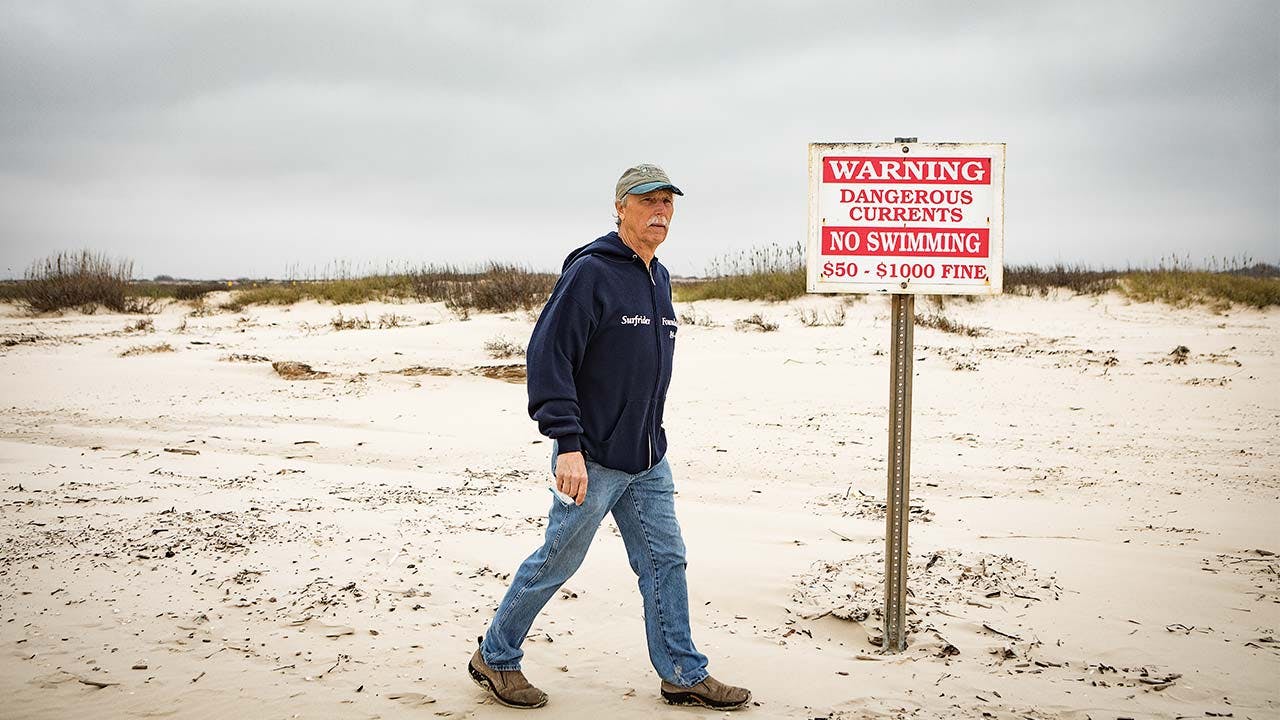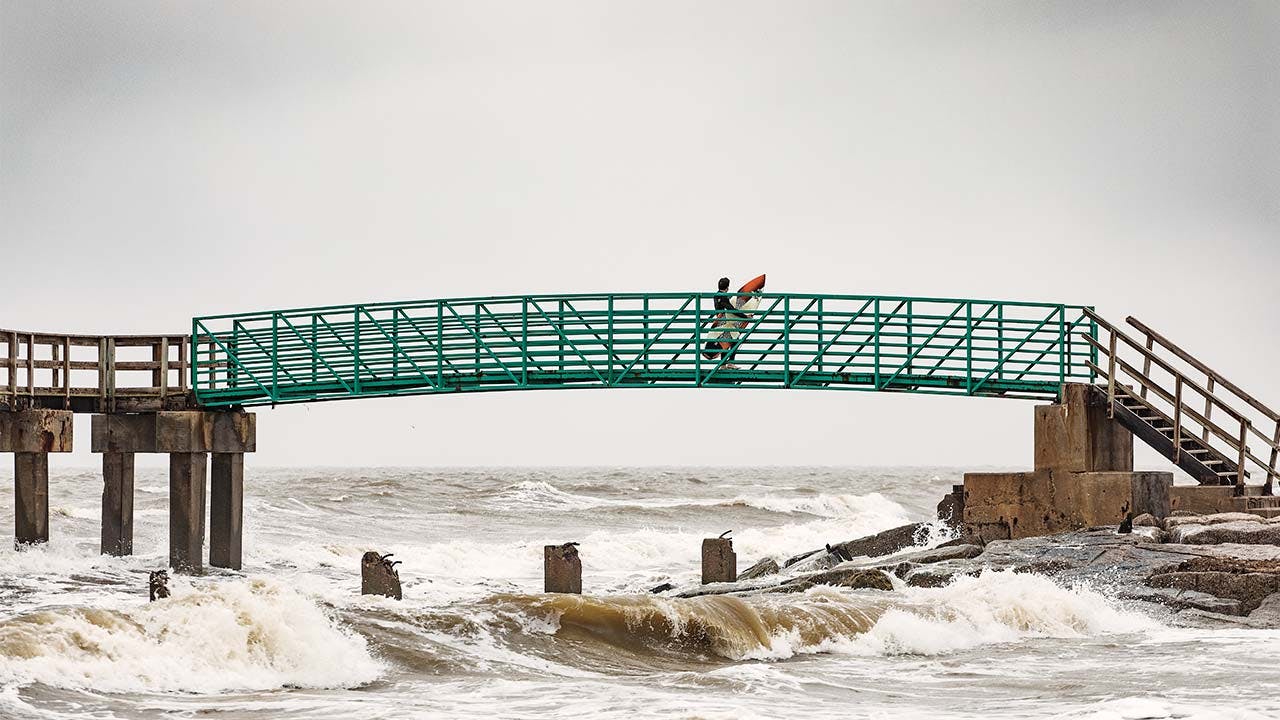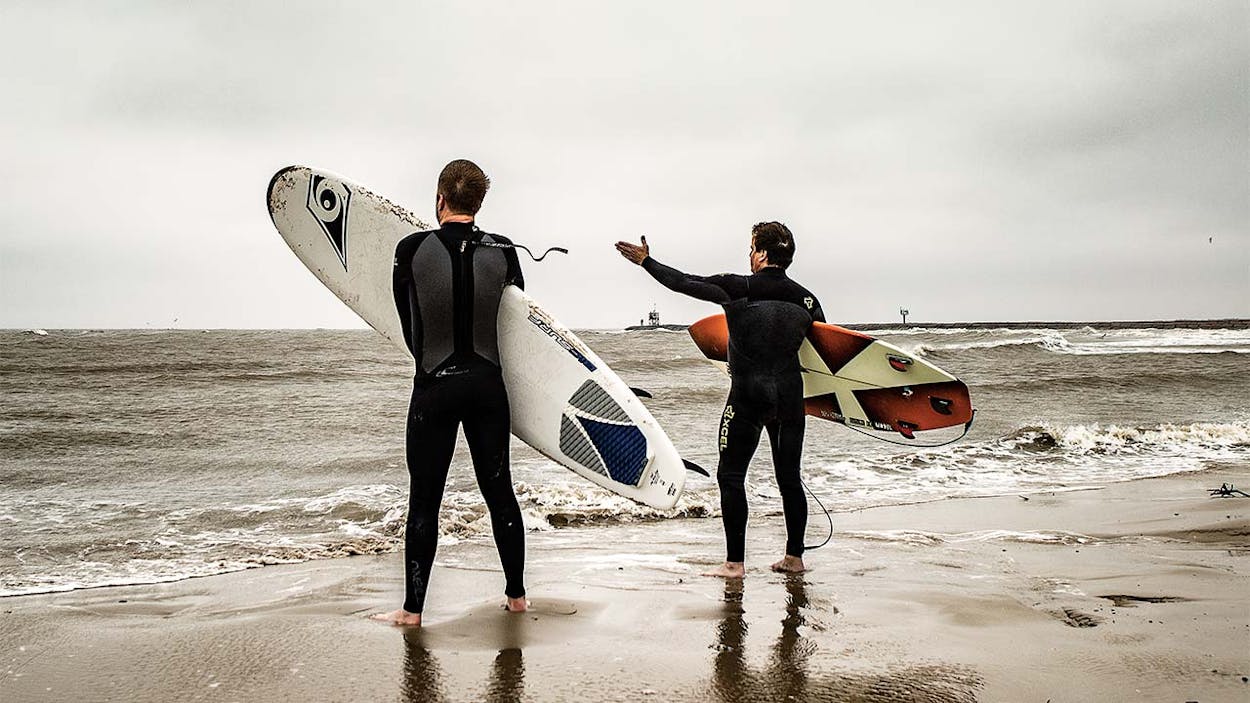Bronson Hilliard remembers the first time he saw Matagorda Bay. It was 1986, he was fifteen years old, and he had driven from Houston, on back roads and past endless cow pastures, to get there. Though Surfside Beach and Galveston, farther up the coast, are known for their rolling waves, that day at Matagorda, not far from where the mud-brown water of the Lower Colorado River empties into the Gulf of Mexico, Hilliard witnessed huge, powerful swells. “I saw the waves lining up, I saw the phosphorescence,” he says. “The waves would break and pitch, and they were lighting up. I’ve only ever seen that two times in my life.”
Matagorda Bay quickly became his favorite surf spot on the Texas Gulf Coast. He used to come here to duck hunt with his dad, but when the wind would move offshore, he’d leave the duck blind, swap his hunting gear for a wet suit and a board, and paddle out to ride the waves as long as he could. “Once it calmed down and the birds started working over the sea trout and the redfish, it was so easy to catch fish,” he says. “Then we’d have a fish fry, ’cause we were hungry from surfing. It’s one of the few places in the country left where you can shoot guns and fish and surf in the same day.”
But Hilliard isn’t sure he’ll be able to do that sort of thing much longer. On a recent February morning, the 46-year-old video producer and his friend Ellis Pickett drove onto Matagorda Beach in Hilliard’s Yukon, zigzagging around the dunes before pulling up at the water’s edge. Pickett, a thin 67-year-old, is the founder of the Texas chapter of the Surfrider Foundation, a nonprofit dedicated to conserving beaches throughout the United States. He’s been surfing at Matagorda for nearly half a century. As the two men disembarked from the Yukon, they pointed out what we’d come to see: numerous “No Swimming” signs that dotted eight hundred feet of beach, each warning of $50 to $1,000 fines.
The county had erected the signs last summer in response to a spate of drownings. But though the signs seem to only target swimmers, the ordinance behind them—which you’d have to contact Matagorda County offices to get ahold of—is more expansive. It reads: “It shall be unlawful for any person . . . to swim or surf from a point 400 feet east of the Colorado River Jetty . . . or from a point 400 feet west of the west bank of the Colorado River.” That ordinance was actually passed in 1991 but apparently had never been enforced until last year.
“If I start getting tickets for doing what I love down here, I won’t be very happy,” Hilliard said.

Matagorda Bay is different from the rest of the Texas Gulf Coast, more isolated, its miles of sand interrupted only by the mouth of the Colorado. To reach the bay, you drive south through the tiny town of Matagorda, which is located nearly at the midpoint between Galveston and Corpus Christi, and then cross the bridge that straddles Saint Mary’s Bayou. Before the road dead-ends at the beach, you’ll pass pastel-colored houses on stilts, commercial fishing boats full of camo-clad fishermen, and a couple of restaurants serving fresh oysters and shrimp.
What makes the bay unique for surfers is the configuration of the three jetties—two on the east of the Colorado’s mouth, one on the west—that were created in 1992 to prevent the river from silting up. Most of Matagorda Bay is a fickle spot for surfers. If the conditions aren’t just right, surfing isn’t possible. But when the rest of the beach is a mess of white foam, the jetties provide a safe harbor of sorts—and cleaner surf. “When they built that second jetty, it provided us with a refuge when conditions weren’t good,” Hilliard says. “I’ve caught a minute-long wave in there. That’s extremely rare in Texas.”
Better still, the underwater shelf here drops off more steeply than it does at Galveston and Surfside, meaning the chances of large waves are greater. “Even when there’s no wind, you can get big swells,” Hilliard says. Which is why experienced Texas surfers drive hours for the privilege of tackling Matagorda’s waves.
But the very characteristics that make Matagorda Bay ideal for surfing also conspire to produce an unseen danger. When breaking waves force water up a beach, the water has to find its way back out to sea. Usually that return flow is evenly spread along a beach. But a jetty can disrupt this pattern, creating a strong, narrow seaward flow known as a rip current. And anyone who finds himself in one can be carried away from shore at terrifying speeds—up to eight feet per second.
That sort of thing seems to be happening more often lately. According to the U.S. Coast Guard’s 8th District, in Corpus Christi, between October 1, 2013, and September 30, 2014 (the earliest span for which numbers are available), it responded to 12 search-and-rescue cases in Matagorda Bay. In 2015 the number rose to 22. In 2016—the year the signs went up—there were only 6. A road bridge that opened in 2009 to replace an old swing bridge, bringing more people to the area, may have been responsible for the rise. “We’ve seen [people die] every year, but, of course, as more and more people visit the beach, it’s really increased,” says Matagorda County Commissioner Kent Pollard, who last year ordered the installation of the signs.
A look through last year’s newspaper clippings offers a glimpse into how easily tragedy can occur. This past summer alone, three people lost their lives in these waters in as many weeks because of fierce rip currents. On May 31, a woman from Bryan drowned as she attempted to save her sixteen-year-old son from the surf (the boy survived). Nearly two weeks later, on June 13, a wade fisherman disappeared while night fishing near the jetties at the mouth of the river. His body was discovered by locals seven miles east the next morning. On June 16 a couple from Matagorda were in a boat heading toward the mouth of the Colorado when the vessel capsized in rough waters; the man survived, but his girlfriend drowned.
Armando Galvan, a police detective in nearby Bay City, knows the dangers here only too well. He and his brother were hanging out in Matagorda two years ago when they noticed some kids in trouble in the water, along with a man and woman who had evidently gone in to help. Galvan dived in and helped get the woman back to the beach. He then went back out to save the children, assisted by a line of people. When Galvan swam out again, he found the man face down in the water. “We pulled him in, but he had already passed,” Galvan says.
It was such events—and the resulting public outcry in the local press and on social media—that prompted Pollard to take action. “Matagorda is a tourist community, and when you have a rash of drownings, it tends to affect the tourist trade,” he says. “The ordinance isn’t there to try to punish the surfers in any shape, form, or fashion. It’s a matter of not having to pull a body out of the water.”

The people who surf in Matagorda Bay know that the tides are dangerous for swimmers. Both Hilliard and Pickett see the wisdom of banning swimmers from the areas near the jetties. What troubles them is the extension of the ban to surfers, who are less at risk, because they’re well aware of the perils of rip currents and have buoyant boards strapped to their ankles. Pickett says that no legitimate surfer has ever drowned at Matagorda, though he says there have been instances where kids on Styrofoam boogie boards have gotten into trouble.
A few years ago, Christian Brannstrom, a professor of geography at Texas A&M, worked on a study to find out how easily people could identify rip currents. “Most got it wrong,” he says. Brannstrom says the majority of people who go to the beach think the greatest danger is big waves. But that’s not always true. “The surfers we asked got it right.” Surfers see what looks like a small patch of calmer water and recognize it as the site of a rip current.
Because of their expertise in the water, surfers are often able to assist swimmers in distress. Shortly after the signs went up on the beach, a surfer posted a message on the Facebook page of the Matagorda County Sheriff’s Office that read: “As a Gulf Coast surfer for 40 years, it is my experience that surfers have saved many lives by rendering aid to people in drowning situations. It is a surfers unwritten rule to do so . . . please reconsider this policy.”
Gene and Rachel Gore, who run the South Padre Surf Company, on South Padre Island, three hundred miles south of Matagorda, often travel to Matagorda Bay for the waves. “Gene and I had our very first date surfing there, and it’s got a very important place in my heart,” Rachel says. “I’m surprised to hear about the ban on surfers; it’s ridiculous. Surfers rescue swimmers regularly on all stretches of the coastline. They’re alert and well aware of surf and water conditions.”
In 2007 three surfers helped a group of boaters from St. Louis who had fallen overboard after being hit by a wave. One of the surfers called 911 while the other two paddled out in 50-degree water. A game warden also approached in his boat, but he too was thrown from his vessel, which sank to the bottom of the Gulf. He and the others made it back to shore by clinging to the three surfboards.
“I realize they’re trying to save lives,” Hilliard says of the county. “But it doesn’t make sense to restrict surfing—we’re already going to be out there if somebody gets in trouble. What’s the sheriff going to do? Come down there, take all his gear off, and jump in the water to try to save some drowning person?”
Pickett notes another problem with the ordinance: it’s often wade fishermen who succumb to rip currents, yet the ordinance doesn’t include them. “They’re not going to stop wade fishermen,” he says, citing the importance of fishing to the local economy. “There would be too much pushback.” Pollard concedes that it might make sense to rethink whether the ordinance should include wade fishermen. (Boats, it should be mentioned, aren’t banned under the ordinance either. Rip currents aren’t ordinarily a threat to boats, but where the river meets the Gulf, waves can topple watercraft, leaving their occupants at the mercy of the water.)
Pickett has tried to convince Pollard and Sheriff Frank “Skipper” Osborne to follow the lead of places like Galveston, which has areas where people can surf but not swim. But progress has been slow. “My job as sheriff is to enforce the laws,” Osborne wrote in an email to texas monthly. “And as long as this is a county law, I will enforce it till changed by the Commissioners Court.”
For now, it seems like nothing will change, unless the local surfers band together and push their local politicians to rewrite the ordinance. But so far, that sort of movement hasn’t materialized. Maybe that’s because many surfers have found a work-around that allows them to keep surfing: for most of the year, they simply ignore the signs. In the winter, spring, and fall, when the surfing conditions are best, the sheriff’s deputies are nowhere to be found. “Unless it’s a summer weekend, cops don’t go down there and check for people surfing,” Hilliard says.
And so, on that February morning, Hilliard stared straight ahead at the ocean. Then, when the wind had swung round to the northeast and the breaks looked good, he slid a six-foot custom board from the back of his Yukon, where it was wedged between a cooler and some fishing rods.
Hilliard paddled out to the break, pointed his board at the shore, and hopped on, effortlessly, before turning toward the jetty, surfing down the line, and plunging into the waves. For forty minutes he shared a small stretch of Gulf with a porpoise that arched and dived, its fin disappearing and reappearing in the surf between those two concrete jetties, while Pickett looked on from the car.
Austin journalist Alex Hannaford has written for the Atlantic, the Texas Observer, and the British editions of Esquire and GQ.







